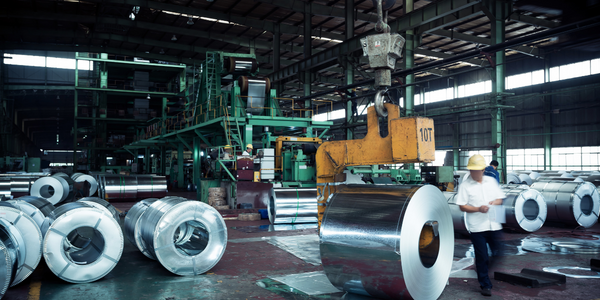Technology Category
- Functional Applications - Manufacturing Execution Systems (MES)
- Sensors - Environmental Sensors
Applicable Industries
- Cement
- Metals
Applicable Functions
- Logistics & Transportation
- Product Research & Development
Use Cases
- Construction Management
- Manufacturing Process Simulation
About The Customer
Re-Loc is a UK-based company that developed a new product to help accelerate the construction process. The product is a clip that fits tightly inside the concrete brick’s cavity and attaches to the steel bar, holding it securely in place. The team had already developed a rough design and proved that it could perform its intended job, but problems arose when it came to the manufacturing cost of the product. With potentially many hundreds if not thousands of the clips being required to fit inside a single structure to hold the bars in place, the product had to be very cheap to produce and easy to use.
The Challenge
Re-Loc, a UK-based company, developed a new product to accelerate the construction process. The product is a clip that fits inside the cavity of a concrete brick and attaches to the steel bar, holding it securely in place. However, the manufacturing cost of the initial design was too high for mass production, given the large number of clips required for a single structure. The challenge was to reduce the material use and cost of the part, bring the design to a production level, and make it as efficient as possible. The part had to be sufficiently stiff to maintain the position of vertical and horizontal bars relative to the inside surfaces of the hollow blocks, allow the concrete to be poured through or around itself, and endure all environmental aspects during use.
The Solution
Re-Loc approached Altair ProductDesign to explore ways of reducing material use and cost from the part. Altair first performed a study to explore materials for the part which needed to have adequate stiffness and strength properties as well as being suitable for low cost, high volume manufacturing. They found that an injection molded polymer or foam would be the best options. They then performed a dynamic simulation analysis on the existing design to discover the current performance levels. With the performance data from the original design captured, Altair performed a topology optimization study on the component to investigate ways of improving the design and removing material. The topology results were interpreted back into a detailed CAD design by Altair ProductDesign and the team applied their experience to suggest further enhancements to the overall design to maximize performance. The final design produced by Altair ProductDesign successfully met the performance targets set at the beginning of the project.
Operational Impact
Quantitative Benefit

Case Study missing?
Start adding your own!
Register with your work email and create a new case study profile for your business.
Related Case Studies.

Case Study
Goldcorp: Internet of Things Enables the Mine of the Future
Goldcorp is committed to responsible mining practices and maintaining maximum safety for its workers. At the same time, the firm is constantly exploring ways to improve the efficiency of its operations, extend the life of its assets, and control costs. Goldcorp needed technology that can maximize production efficiency by tracking all mining operations, keep employees safe with remote operations and monitoring of hazardous work areas and control production costs through better asset and site management.

Case Study
System 800xA at Indian Cement Plants
Chettinad Cement recognized that further efficiencies could be achieved in its cement manufacturing process. It looked to investing in comprehensive operational and control technologies to manage and derive productivity and energy efficiency gains from the assets on Line 2, their second plant in India.

Case Study
KSP Steel Decentralized Control Room
While on-site in Pavlodar, Kazakhstan, the DAQRI team of Business Development and Solutions Architecture personnel worked closely with KSP Steel’s production leadership to understand the steel production process, operational challenges, and worker pain points.

Case Study
Bluescope Steel on Path to Digitally Transform Operations and IT
Increasing competition and fluctuations in the construction market prompted BlueScope Steel to look toward digital transformation of its four businesses, including modern core applications and IT infrastructure. BlueScope needed to modernize its infrastructure and adopt new technologies to improve operations and supply chain efficiency while maintaining and updating an aging application portfolio.

Case Study
RobotStudio Case Study: Benteler Automobiltechnik
Benteler has a small pipe business area for which they produce fuel lines and coolant lines made of aluminum for Porsche and other car manufacturers. One of the problems in production was that when Benteler added new products, production had too much downtime.

Case Study
Continuous Casting Machines in a Steel Factory
With a very broad range of applications, steel is an important material and has been developed into the most extensive alloy in the engineering world. Since delivering high quality is absolutely crucial for steel plants, ensuring maximum productivity and the best quality production are the keys to competitiveness in the steel industry. Additionally, working conditions in steel factories are not suitable for workers to stay in for long periods of time, so manufactures usually adopt various machines to complete the steel production processes. However, the precision of these machines is often overestimated and the lack of flexibility also makes supervisors unable to adjust operating procedures. A renowned steel factory in Asia planned to improve its Distributed Control System (DCS) of furnaces as well as addressing the problem of insufficient accuracy. However, most well-known international equipment suppliers can not provide a satisfactory solution and local maintenance because the project needed new technologies to more accurately control equipment operations. By implementing Advantech’s automated monitoring and control solution, steel factories can not only improve the manufacturing processes but can also allow users to add additional functions to the existing system so as to make sure the operation runs at high efficiency.



